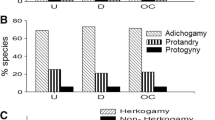Abstract
The extent of self-fertility was examined in 16 populations ofCrepis tectorum. A hypothesis that a weedy habit favours autogamy was only partly supported. Low levels of self-fertility characterized non-weedy populations from calcareous grasslands (“alvars”) on the Baltic island in Öland. By contrast, plants in nearly all weed populations studied were more or less self-fertile. However, the trend towards autogamy may have occurred independently of the trend towards a weedy habit, as shown by moderately to high levels of self-fertility in alvar populations from two other Baltic islands. In the weed group, there was a tendency for plants from two field populations to be more autogamous than plants from more “ruderal” habitats. There was an association between self-fertility and small, inconspicious heads in the alvar group but the association was weaker when weed populations were also considered. The relatively wide heads characterizing the ruderal weed populations may, at least partly, be an indirect effect of increases in overall plant size and/or in the size of the fruit associated with each flower.
Similar content being viewed by others
References
Andersson, S., 1988: Limiting factors on seed production inCrepis tectorum ssp.pumila. — Acta Phytogeogr. Suecica76: 9–20.
—, 1989: Variation in heteroblastic succession among populations ofCrepis tectorum. — Nordic J. Bot.8: 565–573.
Babcock, E. B., 1947: The genusCrepis 1–2. — Berkeley, Los Angeles: University of California Press.
Baker, H. G., 1955: Self-compatibility and establishment after “long-distance” dispersal. — Evolution9: 347–349.
—, 1965: Characteristics and modes of origin of weeds. — InBaker, H. G., Stebbins, G. L., (Eds.): Genetics of colonizing species, pp. 147–172. — New York: Academic Press.
—, 1967: The evolution of weedy taxa in theEupatorium microstemon species aggregate. — Taxon16: 293–300.
—, 1974: The evolution of weeds. — Ann. Rev. Ecol. Syst.5: 1–24.
Bengtsson, K., Prentice, H. C., Rosèn, E., Moberg, R., Sjögren, E., 1988: The dry alvar grasslands of Öland: ecological amplitudes of plant species in relation to vegetation composition. — Acta Phytogeogr. Suecica76: 21–46.
Berglund, B. E., 1966: Late-Quaternary vegetation in eastern Blekinge, southeastern Sweden. 1. Late-Glacial time. — Opera Bot.12: 1–180.
Gibbs, P. E., Milne, C., Carillo, M. V., 1975: Correlation between the breeding system and recombination index in five species ofSenecio. — New Phytol.75: 619–626.
Giles, B. E., Bengtsson, B. O., 1988: Variation in anther size in wild barley (Hordeum vulgare ssp.spontaneum). — Hereditas108: 199–205.
Gottlieb, L. D., 1984: Genetics and morphological evolution in plants. — Amer. Naturalist123: 681–709.
Harding, J., Mankinen, C. B., Elliott, M. H., 1974: Genetics ofLupinus. 7. Outcrossing, autofertility, and variability in natural populations of thenanus group. — Taxon23: 729–738.
Horovitz, A., Harding, J., 1972: Genetics ofLupinus. 5. Intraspecific variability for reproductive traits inLupinus nanus. — Bot. Gaz.133: 155–165.
Hughes, M. B., Babcock, E. B., 1950: Self-incompatibility inCrepis foetida L. subsp.rhoeadifolia. — Genetics35: 570–588.
Königsson, L. K., 1968: The Holocene history of the Great Alvar of Öland. — Acta Phytogeogr. Suecica55: 1–172.
Lande, R., Schemske, D. W., 1985: The evolution of self-fertilization and inbreeding depression in plants. 1. Genetic models. — Evolution39: 24–40.
Lefebrve, C., 1970: Self-fertility in maritime and zinc mine populations ofArmeria maritima (Mill.)Willd. — Evolution24: 571–577.
Lloyd, D. G., 1965: Evolution of self-compatibility and racial differentiation inLeavenworthia (Cruciferae). — Contr. Gray Herb.195: 1–134.
—, 1979: Some reproductive factors affecting the selection of self-fertilization in plants. — Amer. Naturalist113: 67–79.
Moore, D. M., Lewis, H., 1965: The evolution of self-pollination inClarkia xantiana. — Evolution19: 104–114.
Mulligan, G. A., Findlay, J. N., 1970: Reproductive systems and colonization in Canadian weeds. — Canad. J. Bot.48: 859–860.
Ornduff, R., 1969: Reproductive biology in relation to systematics. — Taxon18: 121–133.
Pettersson, B., 1958: Dynamik och konstans i Gotlands flora och vegetation. — Acta Phytogeogr. Suecica40: 1–288.
—, 1965: Gotland and Öland. Two limestone islands compared. — Acta Phytogeogr. Suecica50: 131–140.
Primack, R. B., 1987: Relationships among flowers, fruits and seeds. — Ann. Rev. Ecol. Syst.18: 409–430.
Richards, A. J., 1986: Plant breeding systems. — London: Allen & Unwin.
Rick, C. M., Fobes, J. F., Tanksley, S. D., 1979: Evolution of mating systems inLycopersicon hirsutum as deduced from genetic variation in electrophoretic and morphological characters. — Pl. Syst. Evol.132: 279–298.
Schoen, D. J., 1977: Morphological, phenological, and pollen-distribution evidence of autogamy and xenogamy inGilia achilleifolia (Polemoniaceae). — Syst. Bot.2: 280–286.
—, 1982: The breeding system ofGilia achilleifolia: variation in floral characteristics and outcrossing rate. — Evolution36: 352–360.
Solbrig, O. T., 1967: Some aspects ofCompositae of evolutionary interest. — Taxon16: 304–307.
Stebbins, G. L., 1957: Self-fertilization and population variability in the higher plants. — Amer. Naturalist91: 337–354.
Sterner, R., 1938: Flora der Insel Öland. — Acta Phytogeogr. Suecica9: 1–169.
Strid, A., 1970: Studies in the Aegean Flora. 16. Biosystematics of theNigella arvensis complex. — Opera Bot.28: 1–169.
Thomas, S. M., Murray, B. G., 1981: Breeding systems and hybridization inPetrorhagia sect.Kohlrauchia (Caryophyllaceae). — Pl. Syst. Evol.139: 77–94.
Wyatt, R., 1984: The evolution of self-pollination in granite outcrop species ofArenaria (Caryophyllaceae). 1. Morphological correlates. — Evolution38: 804–816.
Author information
Authors and Affiliations
Rights and permissions
About this article
Cite this article
Andersson, S. The evolution of self-fertility inCrepis tectorum (Asteraceae). Pl Syst Evol 168, 227–236 (1989). https://doi.org/10.1007/BF00936101
Received:
Revised:
Issue Date:
DOI: https://doi.org/10.1007/BF00936101




